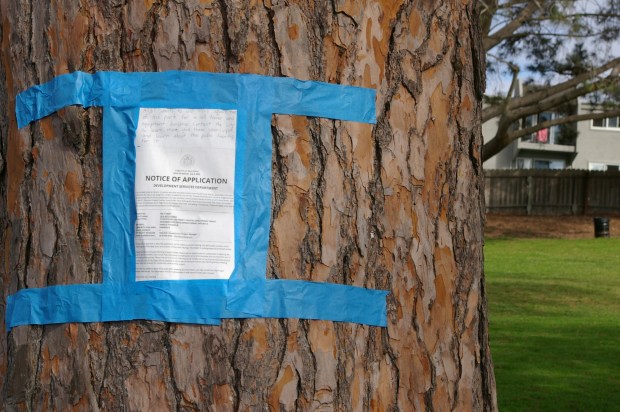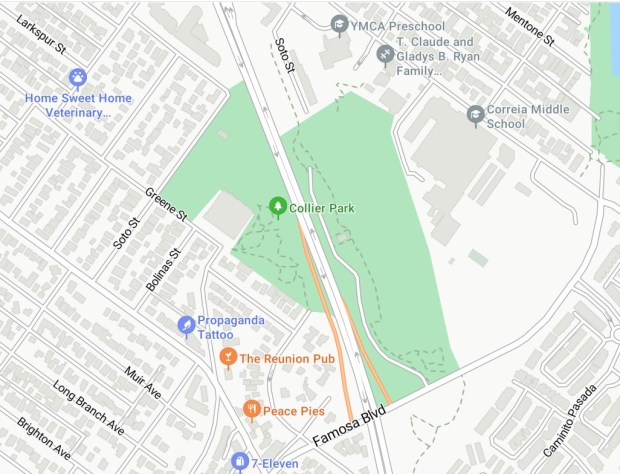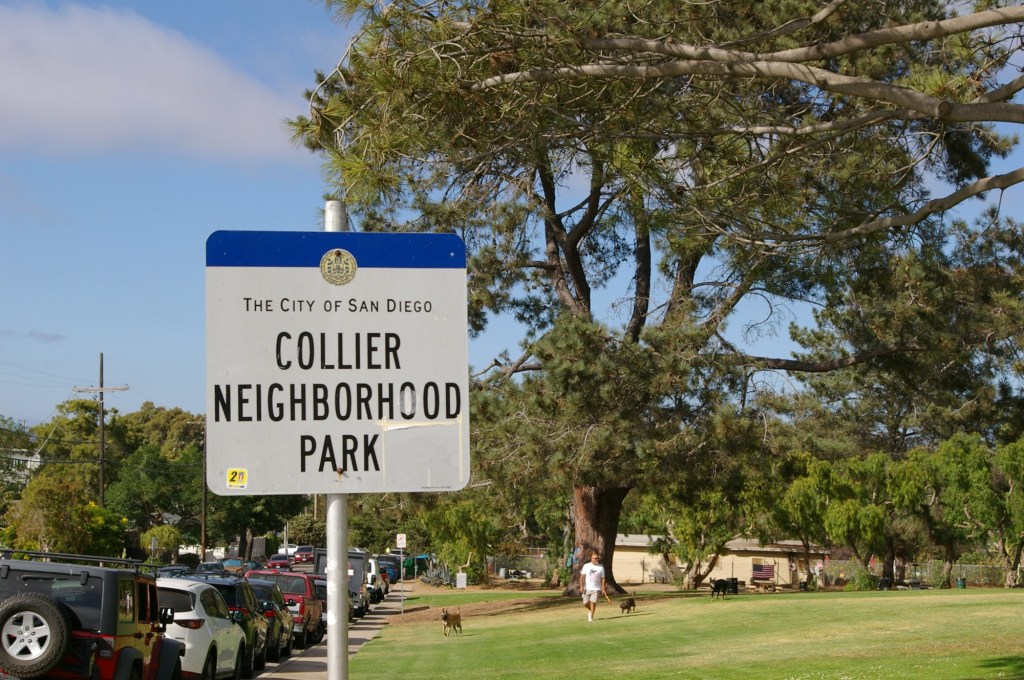A project that seeks to install a 30-foot cell tower in Point Loma’s Collier Park is drawing community opposition as it goes through the city of San Diego’s review process.
The city Development Services Department sent a notice of application dated July 2 to nearby tenants and homeowners.
According to the notice, the project proposed by AT&T would install a 30-foot-tall “faux mono-eucalyptus” tree that would house 12 antennas and nine remote radio units, or transceivers. The plan also calls for a 395-square-foot ground-mounted equipment enclosure surrounded by landscaping and screening, as well as a 30-kilowatt generator, cables and protective fencing.
Scott McCaskill, chairman of the Advocacy Committee for the Ocean Beach Community Foundation, said community consensus seems to be against the project, largely because of its proposed site in Collier Park at 2351 Soto St., near the eastern boundary of Ocean Beach. The park’s neighbors include the Ocean Beach Community Garden, Greencliff Apartments and dozens of other homes.
“There is a petition on Change.org that has over [380] signatures so far,” McCaskill noted. “There have been numerous posts on social media about it, and if you go out to the park, they have a couple notices posted in the park with some graffiti of colorful language in opposition to the proposal.”
The online petition was launched July 5, just three days after the notice of application was distributed by the Development Services Department.
 A notice of application from the San Diego Development Services Department about AT&T’s cell tower proposal is taped to a tree at Collier Park, along with a handwritten note encouraging neighbors to attend community meetings about it. (Tyler Faurot)
A notice of application from the San Diego Development Services Department about AT&T’s cell tower proposal is taped to a tree at Collier Park, along with a handwritten note encouraging neighbors to attend community meetings about it. (Tyler Faurot)
The petition cites “visual blight,” loss of public space, risk to nearby property values and concerns about health and safety as the primary reasons for opposing the project.
“Although research is ongoing, many residents are understandably concerned about the proximity of high-frequency antennas to homes, children and pets,” the petition states.
Federal law prohibits local governments from regulating the placement, construction and modification of wireless service facilities on the basis of environmental concerns about radio frequency (RF) emissions if the facilities comply with Federal Communications Commission regulations for those emissions.
Wireless equipment produces electromagnetic fields, or EMFs, with varying frequencies. New-generation 5G wireless has a higher frequency than previous generations, enabling it to carry more information at greater speed.
EMFs from cellphones, computers, power lines and microwaves consist of non-ionizing, low-level radiation. Ionizing EMFs, such as from sunlight and X-rays, have much higher-level radiation.
The highest 5G frequency ranges from 24.25 GHz to 52.6 GHz, where data transfer speed is greatest.
Research published in the Journal of Exposure Science and Environmental Epidemiology said it found “no confirmed evidence that low-level RF fields … such as those used by the 5G network are hazardous to human health.”
On the other hand, the National Institute of Environmental Health Sciences noted that “concerns persist about possible connections between EMF and adverse health effects.”
The institute said additional research is needed, though it recommended “continued education on practical ways to reduce exposures to EMFs.”
The issue of whether the project would “mar the natural and open look” of the neighborhood, as opponents contend, could be a continuing subject of discussion in coming months.
 Collier Park at 2351 Soto St. neighbors the Ocean Beach Community Garden, Greencliff Apartments and dozens of other homes. (Bing Maps and Point Loma-OB Monthly)
Collier Park at 2351 Soto St. neighbors the Ocean Beach Community Garden, Greencliff Apartments and dozens of other homes. (Bing Maps and Point Loma-OB Monthly)
The Peninsula Community Planning Board, a group that advises the city on land-use issues in the area, can provide input on questions of aesthetics and community impact.
“In general, [cell tower] contractors do a pretty good job with the aesthetics,” said PCPB Chairman Eric Law. “Most of the issues arise from community impact. For instance, locating a faux tree … in a nature preserve might seem like a good idea to the contractor, but [not] the community.”
Because this project is being reviewed discretionally, public input through community planning groups is taken into account.
Neighbors looking for an opportunity to share their feedback may have to wait awhile. The project was initially slated for a presentation to the Peninsula Community Planning Board in July, but the presenters rescheduled.
“The applicant withdrew it from [the] meeting to be better prepared, likely when they found out about the public opposition,” Law said. “Since the board doesn’t meet in August, we won’t see the project until September.”
The applicant named for the project is Harold Thomas Jr., a team lead for MD7, a telecommunications consulting firm.
Thomas did not respond to requests for comment. Brian Mackey, a site acquisition manager for MD7, said the company does not comment about upcoming projects.
Chris Collins, a communications manager for AT&T, said he had “nothing to announce at this time” and that AT&T “typically [does not] discuss future plans.”
Nilia Safi, a telecommunications project manager for the Development Services Department, said that once all outstanding comments have been addressed, the project will be scheduled for a public hearing by the city Planning Commission.
A notice of that hearing will be mailed to nearby residents and property owners, Safi said.
McCaskill said the Ocean Beach Community Foundation plans to discuss the project at its meeting on Thursday, Aug. 14, when “people can either air their grievances or show support if they want to.”
The meeting is scheduled for 7-9 p.m. at Ocean Beach Elementary School, 4741 Santa Monica Ave.
“Usually at our meetings we have some representatives from [City Councilwoman] Jen Campbell’s office or Mayor [Todd] Gloria’s office,” McCaskill said. “It’s a good opportunity to talk directly to people with an ear of the decision-makers.”
AT&T in February withdrew a similar application to install wireless communications equipment in La Jolla after vocal opposition by residents there.
AT&T had submitted plans to the city to install a 30-foot cell tower and nine antennas on six smaller mounts along the La Jolla Bike Path to “enhance broadband connectivity and capacity in the area for emergency service and wireless customers.”
The company did not provide a reason for the withdrawal, but residents voiced concerns similar to those of opponents of the Collier Park proposal.
— La Jolla Light staff writer Ashley Mackin-Solomon contributed to this report.
Originally Published: July 29, 2025 at 3:34 PM PDT
